
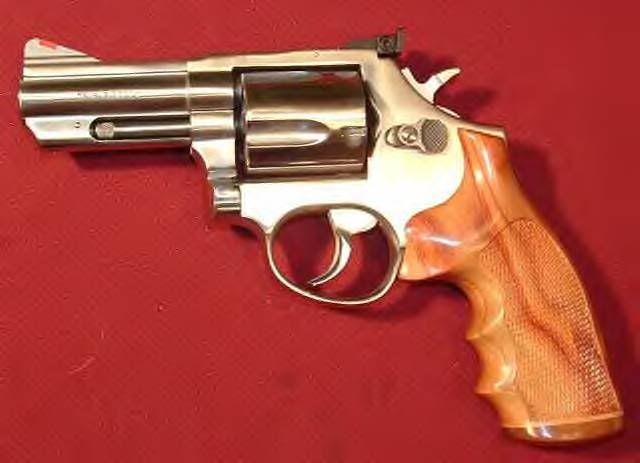
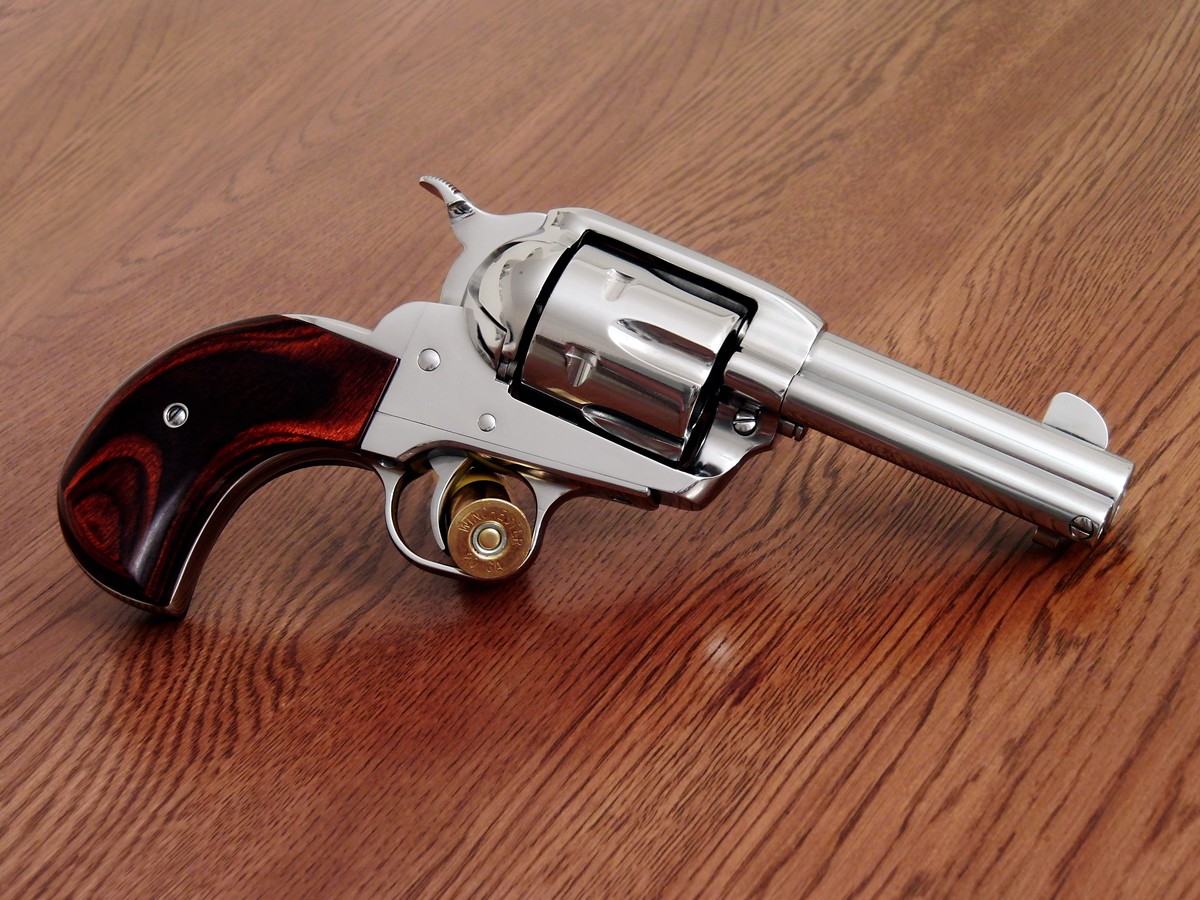
Now besides the obvious sexism of the Picture below. It also does not make me a happy camper. Since it could give some not too bright folks. A lot of really dumb / potently tragic ideas about handling a gun.
Or this one! Especially since Col. Mikhail Kalashnikov should know better than to have his finger on the Trigger!
or how about this one! I am sure that Handgun Control will have this one on their Website soon!

Or Do not get me going on these Videos games! Talk about desensitizing folks about violence.

If you have any other pictures about dumb gun stuff / stunts. Please forward them to me and I will share them!
Thanks Grumpy!
(I feel better now)

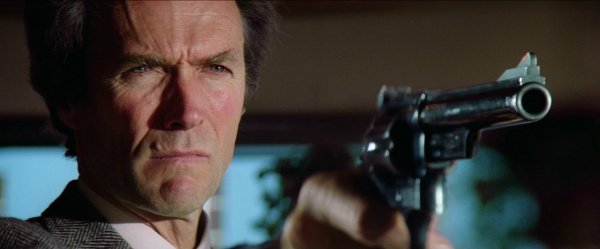
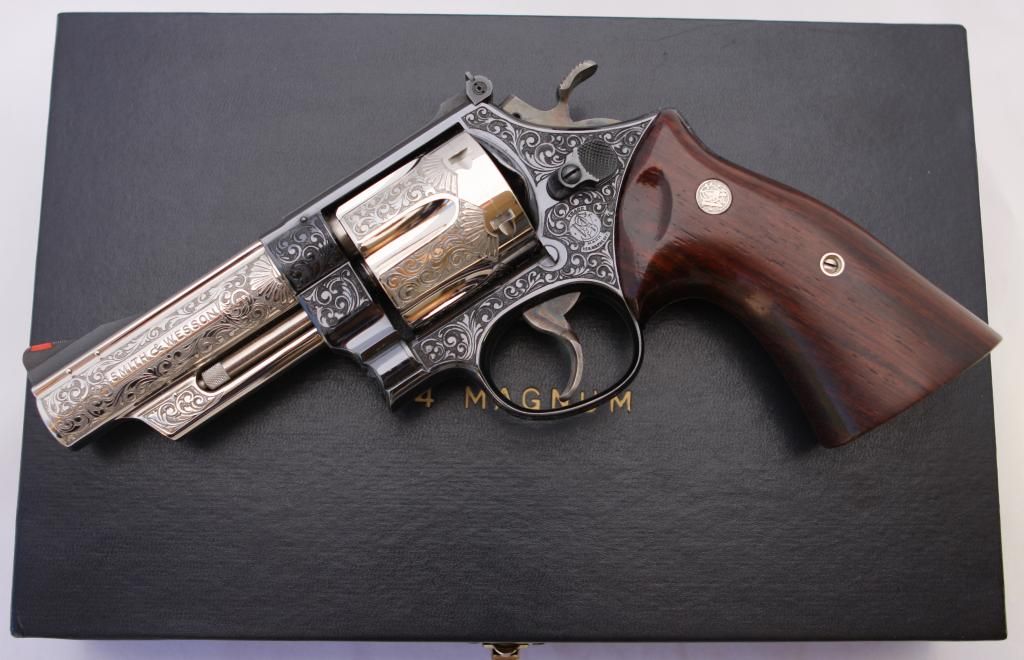

Yeah I know! “Go ahead and make my day!” I just knew that you were going to think that! Well here goes nothing.
I was first introduced to this Hand Cannon back in 1979 AD. When I got my first real job delivering Booze to the alcoholics from the local Liquor Store. (Thanks Ed & Dan for the chance you gave me!)
So when I got paid from that great job. I roared over to the local Gun Shop. Where the owner kindly let me do a layaway on a brand new Model 29 in Blue. Time then passed very slowly for me.
But the great day finally showed up and off I went with my new toy.
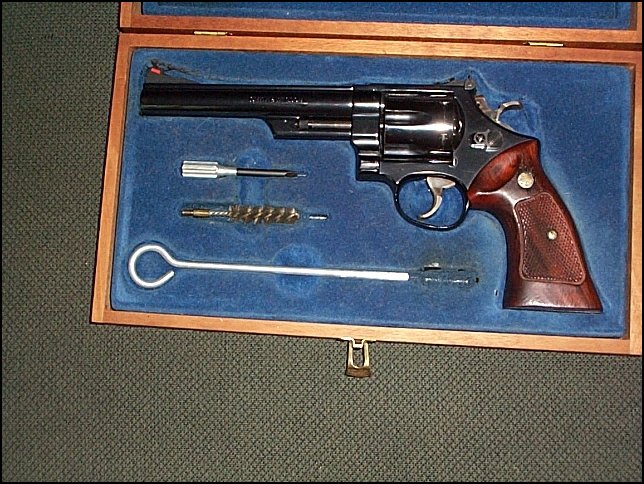
Back then S&W gave you a really nice Wooden Box to go with it. Even my Dad was impressed by it. So of course off I went to put it thru its paces.


Now at this time I had seen a few of the Dirty Harry Movies. So I was convinced that this piece was going to kick like a Missouri Mule.
To say that I was nervous would be a slight understatement. But really it was not bad at all. Since I had fired Dad’s Colt Commander in 45 ACP. Which frankly had a lot more felt recoil & report.

Now the place I shot at was owned by my Grandfather. Where was a old 50 gallon drum filled with rainwater. So being the dumb kid that I was. I put my first 6 rounds thru it.
What I found out was that this 6 inch monster would easily punch a hole in it. But would not punch an exit hole. Humph! But none the less it did produce a nice shock wave of water coming out of the barrel top.
Bottom line – It’s a keeper! In that whenever I go to the range. It gets a lot of attention. Especially when I crank off a full power Magnum round.
Also if you want to do some “normal” target shooting. You can not go too far wrong with the 44 Special. As I have seen it do some really spectacular patterns. Especially when my Son is shooting with it.
That & I would also feel sorry for a Bad guy being hit by one of these rounds. As it would no doubt do its duty. If you have done a proper shot placement that is.

Thanks for reading this!
Grumpy
Here is some more information below:
Smith & Wesson Model 29
| Smith & Wesson Model 29 | |
|---|---|
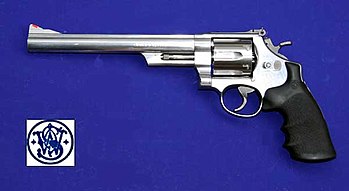
|
|
| Type | Revolver |
| Place of origin | United States |
| Service history | |
| Used by | See Users |
| Production history | |
| Manufacturer | Smith & Wesson |
| Produced | 1955–Present |
| Specifications | |
| Weight |
|
| Length |
|
| Barrel length |
|
|
|
|
| Cartridge | |
| Caliber | .429 in (10.9 mm) |
| Action | Double-action |
| Feed system | Six round cylinder |
| Sights | Open, adjustable rear |
The Smith & Wesson Model 29 is a six-shot, double-actionrevolver chambered for the .44 Magnum cartridge and manufactured by the U.S. company Smith & Wesson.
The Model 29 was offered with 3″, 4″, 5″, 6″, 6½”, 8⅜” and, later, 10⅝” barrel lengths as standard models. Other barrel lengths were available either by special order from Smith & Wesson’s Custom Shop or custom built by gunsmiths. The 5″ barreled variant had a full length underlug. Finish options available included a highly polished blued or nickel–platedsurface.
At the time of its introduction, the Model 29 was the most powerful production handgun. It was made famous by association with the fictional character “Dirty Harry” Callahan.
Contents
[hide]
Design[edit]
The Model 29 will chamber and fire .44 Special cartridges, as the .44 Magnum was developed from the .44 Special. The Magnum case is slightly longer to prevent magnum rounds from being chambered and fired in handguns chambered for the .44 Special.
History[edit]
Elmer Keith‘s achievements in maximizing the power and performance of the .44 Special was the inspiration and driving force behind the introduction of the .44 Magnum by Smith & Wesson. His intention for the new round was for it to be used in sidearms for hunters of large, dangerous game, rather than for self-defense, though with today’s specialty cartridges, it can be a good defensive round.[1]
S&W’s production of a large N-frame revolver in .44 Magnum began in 1955; the Model 29 designation was applied in 1957.[2]
At the time of its introduction, the Model 29 was the most powerful production handgun. There were a number of custom calibers that were more powerful, as in the old Howdah pistols of the 19th century.
It remained primarily the province of handgun enthusiasts, some law enforcement personnel and hunters until 1971, when Clint Eastwood made it famous as “the most powerful handgun in the world” in the movie Dirty Harry. After the movie’s release, retailers had trouble keeping the Model 29 in stock.[3]
In the late 1990s, Smith & Wesson discontinued production of many models of revolvers, including the ‘basic’ Model 29; since then, at various times, the model, in limited or ‘custom’ configurations, has been manufactured in as many as 10 evolutions.[4]
Variants[edit]
The original Model 29 was superseded by the Model 29-1 in 1960, with modifications made to the ejector-rod screw. The Model 29-2 replaced it the following year, with one screw that had secured the cylinder-stop spring being deleted. The barrel length was shortened from 6 1/2″ to 6″ in 1979. These two versions are known as “pinned and recessed”. “Pinned” means that the barrels are screwed in, and secured by a pin driven through the frame and a notch in the barrel. “Recessed” denotes the rear of the bored cylinder holes being countersunk, so that, when loaded, the cartridge rims are fully enclosed by the cylinder. In 1982, the cost-cutting Model 29-3 dropped recessed cylinders and pinned barrels for crush-fit barrels.[2]
The -4 and -5, produced from 1988 and 1990 respectively had changes to improve durability for heavy use. In 1994 the 29-6 began production, now fitted as standard with rubber Monogrips from Hogue to replace the previous wooden items, standard tapped holes also being provided for attaching scope mounts. The 29-7 started production in 1998 with changes to the locking mechanism, the firing pin’s attachment, and a hammer and trigger produced with a metal injection molding process.[2]
| Model | Start Year | Barrel Lengths | Modifications |
|---|---|---|---|
| 29 | 1957 | 6 1/2″ | |
| 29-1 | 1960 | 6 1/2″ | ejector rod screw |
| 29-2 | 1961 | 6 1/2″ changed to 6″ in 1979 | one screw that had secured the cylinder stop spring dropped |
| 29-3 | 1982 | dropped recessed cylinders and pinned barrels for crush-fit barrels | |
| 29-4 | 1988 | retention system on the yoke or cylinder crane strengthened, studs in frame were radiused; 8 3/8″ version offered with integral scope mts. | |
| 29-5 | 1990 | longer cylinder notches to prevent bolt jump, bolt and inner mechanism changed to reduce battering under recoil | |
| 29-6 | 1994 | standard with rubber Monogrips from Hogue | |
| 29-7 | 1998 | changes to the locking mechanism, the firing pin’s attachment, and a hammer and trigger produced with a metal injection molding process. | |
| 29-8 | 2001 | new frame design with internal lock | |
| 29-9 | |||
| 29-10 |
| Starting Number | Years |
|---|---|
| N1 | 1969-1972 |
| N100000 | 1973 |
| N200000 | 1974-1977 |
| N300000 | 1975-1976 |
| N400000 | 1977-1978 |
| N500000 | 1978-1980 |
| N600000 | 1979-1980 |
| N700000 | 1980 |
| N800000 | 1980-1983 |
| N900000 | 1982-1986 |
Model 629[edit]
Introduced in 1978, the Smith & Wesson Model 629 is a stainless steel version of the Model 29.
The 629 model designation derives from Smith & Wesson’s practice of denoting a stainless steel version of one of their already existing designs by placing a 6 in front of the model number of the original weapon. The 629 Classic variant features a full-length barrel underlug, other variants include the 629 Stealth Hunter.
| Model | Start Year | Barrel Lengths | Modifications |
|---|---|---|---|
| 629 | 1978 | ||
| 629-1 | 19xx | dropped recessed cylinders and pinned barrels | |
| 629-2 | |||
| 629-3 | |||
| 629-4 | |||
| 629-5 | Internal hammer added | ||
| 629-6 | Internal lock added |
Quiet Special Purpose Revolver[edit]
Some S&W model 29s were rebuilt by the AAI Corporation to make the Quiet Special Purpose Revolvers (QSPR). These had new, short, smoothbore barrels (35 mm / 1.375 inch), with .40″ / 10mm bore, with cylinder chambers reamed to accept special QSPR ammunition which externally resembled metal-cased .410-gauge shotgun shells but internally worked as a piston to trap the gases. This special ammunition was made by AAI.[5]
This pistol was developed from 1967 to 1971 to be used by tunnel rats in the Vietnam War. The QSPR was tested on the battlefield in 1969, and an improvement and testing program ran from 1970 until 1971. At least officially it never entered service. The US withdrawal from Vietnam reduced interest in the QSPR weapon, and the program ended in about 1972.[5]
A Russian handgun of more-recent vintage, the Ohs-38 Stechkin, is described as using a system virtually identical to that employed by the Quiet Special Purpose Revolver (QSPR).
Mountain Gun Variation[edit]
The Mountain Gun was introduced in 1989 as a lightweight version of the Model 29 designed to be “carried often and shot little”.[6] The barrel profile is a reprise of the original design. Early version 29-4 backpacker with 2.5″ barrel, (Very rare).
A Smith & Wesson Model 629 with a 3″ barrel called the “Trail Boss” was produced for the distributor, RSR.[7]
Other variants[edit]
- On January 26, 2006, Smith & Wesson announced the 50th Anniversary Model 29.[8] Identical to the previous models except for the gold inlaid trademark on the side cover, the new internal lock mechanism, and a non-fluted cylinder.
- On January 1, 2007, Smith & Wesson announced the reissue of the Model 29 as an engraved model in S&W’s Classics line.[9]
- The Smith & Wesson Model 629 Stealth Hunter has a 7.5″ ported barrel with a full-length under lug for increased stability and recoil reduction.The barrel-cylinder gap is 0.006 in (0.1524 mm), with a ball-detent lockup between the frame and cylinder crane that provides increased strength. The entire revolver is made of a stainless steel, with a glare-reducing matte black finish. It comes with slip-resistant synthetic grips.[10]
- The 329NG is a scandium-framed revolver with PVD-coated cylinder and tritium sights. It is part of the NightGuard line.[11]
In popular culture[edit]
The Model 29 became popular at gun stores following its use by the fictional character “Dirty Harry” Callahan from the Dirty Harry series of films starring Clint Eastwood.[3] It’s also prominently featured in the film “Taxi Driver” and the TV series “Sledge Hammer!“.
I never saw this at School! Did you?

But then I went to School in the People’s Republic of California!

More Diversity






:fill(FFCC00,1)/about/Marshall-56a48cce5f9b58b7d0d7816e.jpg)

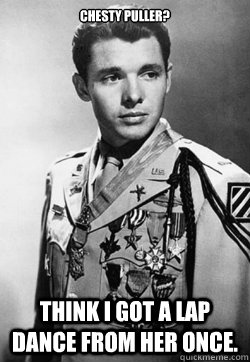
The Bren Gun

One of the only guns that I know of that had its own designed in mind vehicle. The Bren carrier

**Trigger Warning, Some serious bragging is coming up**
Now I have seen this machine gun a couple of times. Once at the Imperial War Museum in London. Where I was allowed to pick it up. Somebody trying to & did win a Victoria Cross in WWII Burma
At 22 pounds, I really feel sorry for the poor guy who had to hump this on a route march of any distance. The other time at a Machine Gun shoot at a very hot and nasty place.
From what I saw about it was that it was a pretty good squad machine gun for its time. Frankly I think that it was almost as good as the M-60 MG. That I served with in the Army.
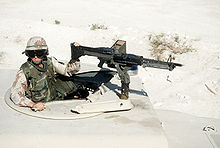
Now here is a couple of strange things that I noticed about it. Because the British / Commonwealth / Empire Army was stuck with the 303 Enfield Rimmed Round. It had to use and curved magazine that is mounted on top.
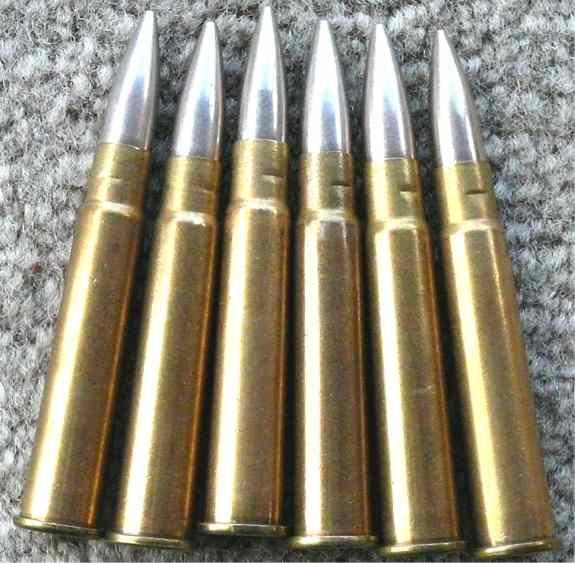 So when you cranked off a round. Gravity would help in both ejecting and feeding it another round. Pretty smart thinking says I.
So when you cranked off a round. Gravity would help in both ejecting and feeding it another round. Pretty smart thinking says I.

I am also willing to bet that it was mighty useful that both the Rifleman and the Bren Gunner used the same ammo. Always a good thing when high speed metal is flying around.
The other thing that struck me about this gun. Is the sight system that it uses. Because of the magazine blocks a straight view across the barrel. The sights have to be offset on the right hand side. 
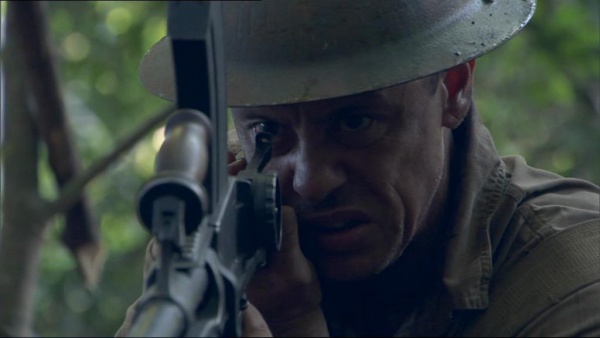
Now for some good news! First off way the Troops found that the Bren was too accurate! In that a good man could literally & consistently put a round thru the same hole. Again & again.
So a smart Trooper would hold on to a worn barrel. In order to get a better pattern when time came for suppressive fire.
Also after the war. The British Army wisely kept this gun inservice right up to the Falklands War in the early 1980’s. But wisely had it rebarreled in the 308 NATO round. I am told in this form it also gave the Crown great service. Notice the straight magazine compared to the earlier model. As the 308 round is rimless.
Notice the straight magazine compared to the earlier model. As the 308 round is rimless.
Here below is some more good stuff about this stout Warrior
WW2 Weapons: The Bren Gun
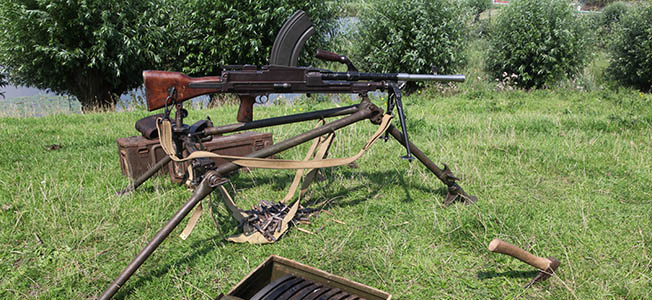
One of the most iconic British WW2 weapons today, the Bren Gun was in short supply in 1939 but quickly became the backbone of the British infantry.
by Arnold Blumberg
While all the combatant nations engaged in World War I fielded machine guns during the conflict, the British Army’s Vickers was arguably the best medium machine gun of the war, while their Lewis gun—an American design but perfected by the English—was the most effective light machine gun.
However, both weapons had their problems. The Vickers Machine Gun was a heavy Maxim-type weapon. Water-cooled and belt-fed, it was very reliable. But it was also a very complex war tool requiring a specially-trained crew, and the weight of the gun and the prodigious amount of water and ammunition it required meant the Vickers was restricted to a purely static defensive role.
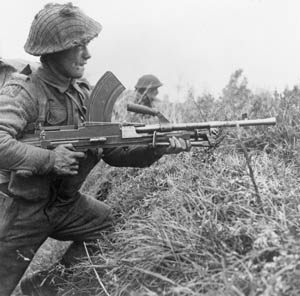
The Lewis gun had been adopted during the Great War to provide close support for advancing troops. It had an air-cooled barrel and fired .303 caliber bullets from a 47-round pan magazine mounted on the top of the piece. Unfortunately, the Lewis gun was still relatively bulky, complicated, suffered from a high rate of stoppages, and could not maintain sustained rates of fire due to its barrel overheating, causing the gun to simply stop working.
Replacing the Vickers & Lewis
Faced with the shortcomings of their standard medium and light machine guns, the British Army sought to replace both in the 1930s. That year, a contender to replace the Lewis gun appeared in the form of the Zb 26: a light, air-cooled, magazine-fed weapon produced by the Brno Firm of Czechoslovakia. Modified to shoot the standard British Army infantry and machine gun .303 caliber ammunition (or 7.7x56mm), the gun—now designated the Zb 30, with a 30 round curved magazine—caught the attention of the Small Arms Committee. After a few minor alterations, the Czech fire arm-called the ZBG 34, was adopted by the Army. Referred to as the BREN, from “Brno” and “Enfield”, assembly lines were set at the Royal Small Arms Factory in 1935, with the first finished product appearing in September 1937.
Introducing the Bren Gun
The original Bren gun was designated the Mark 1. It was capable of semi or fully automatic fire from a distinctive curved top-mounted 30-round magazine. It was 45.5 inches in overall length, and employed a quick-change 25-inch barrel, which could be replaced in seconds, allowing it to keep up a sustained rate of fire. The Bren gun used a magazine rather than the better belt-fed system due to the theory (proved incorrect by the Germans with their MG 34 and MG 42s) that the former made the weapon more portable. The piece weighed 22 pounds and 3 ounces, and fired 500 rounds per minute.
Throughout the Second World War, the Mark 1 Bren was modified three times to include the models Mark II, Mark III, and Mark IV. The same .303 caliber ammunition as the Mark 1 was used, so the differences between these patterns were a few pounds of weight and inches shaved off the later model’s overall length and barrels. In mid-1944, the Bren was standardized as the Mark III with a full length of 42.9 inches, barrel length 22.25 inches, and weighing 19 pounds and 5 ounces. Its effective range was 600 yards. It was essentially a lightened Mark 1, but fitted with a simpler ladder back sight of the Mark II, a shorter and lighter barrel (which reduced accuracy) and simpler butt. Over 57,600 Mark IIIs were produced during the war.
Backbone of the British Infantry
 During World War II, the Bren gun became the backbone of the British infantry. Every infantry section of ten men (equivalent to an American rifle squad) and its combat tactics were built around the Bren light machine gun, with the section’s riflemen tasked with augmenting the firepower of the Bren. Each infantry section contained a seven-man Rifle Group, and a three man Bren gun Group. In addition to carrying extra Bren gun ammunition, the Rifle Group would provide security and replacements for the Bren gun crews, while the Bren gunners provided the main killing power of the infantry section.
During World War II, the Bren gun became the backbone of the British infantry. Every infantry section of ten men (equivalent to an American rifle squad) and its combat tactics were built around the Bren light machine gun, with the section’s riflemen tasked with augmenting the firepower of the Bren. Each infantry section contained a seven-man Rifle Group, and a three man Bren gun Group. In addition to carrying extra Bren gun ammunition, the Rifle Group would provide security and replacements for the Bren gun crews, while the Bren gunners provided the main killing power of the infantry section.
In addition to the Bren in each infantry section, every infantry battalion included a carrier platoon made up of 13 Universal Carriers (unofficially called “Bren Gun Carriers”) in four sections of three vehicles each. Each conveyance carried a Bren gun and a three-man crew. Further, support units (ie,. supply, artillery) carried on their rosters Brens for close defense and anti-aircraft protection.
Bren guns were integral in anti-tank warfare. Although not able to knock a tank out with their small arms ammunition, their fire would cause the enemy tank crews to “button up,” limiting their fields of vision, and dispersing opposing infantry supporting the tanks. Anti-tank weapons could then be brought to bear on the steel monsters with less risk to the attackers.
Useful in the Far East and Western Front
When war broke out on September 1, 1939, the Bren had only been recently adopted by the British Army and was in short supply. After the British evacuation of France in June 1940, only 2,300 Bren guns were available for service. A chronic shortage of the weapon persisted until late 1942, when production of the gun by the UK, Canada, and Australia made up the shortfall. By war’s end Bren guns were in plentiful numbers with all British combat divisions: 1,262, 1,376, and 966 in infantry, armored, and airborne, respectively.
In the Far East, Commonwealth soldiers appreciated the Bren’s portability, as much of the fighting took place in swamps and the jungle and where the armament’s heavy caliber rounds could easily penetrate the thick vegetation. The Australians took to the Bren very quickly, using it as a heavy automatic rifle rather than a machine gun.
When the Allies landed in Italy in 1943, and then in France the next year, the Bren was not affected by the bitter winters found in those theaters of the war. More importantly, it allowed the British infantry, still equipped with bolt-action Enfield Rifles, to maintain a respectful rate of fire compared to the Americans’ use of the semi-automatic Garand Rifle, and the Wehrmacht’s employment of the excellent MG-42 Light Machine Gun.
The Bren gun, in its last incarnation—the post-World War II L4A4—was effectively removed from active service in the mid-1980s being replaced by the L86 Light Support Weapon. While never completely replacing the Vickers, the Bren did serve as the primary support arm for British and Commonwealth troops through World War II and Korea, and set the British small-unit infantry tactics on a path they would follow until the 1980s.
Originally Published January 20, 2015
Makes sense to me!

A Plea for Help!
Thank you for reading my Humble Blog!











 Email This Post
Email This Post Print This Post
Print This Post